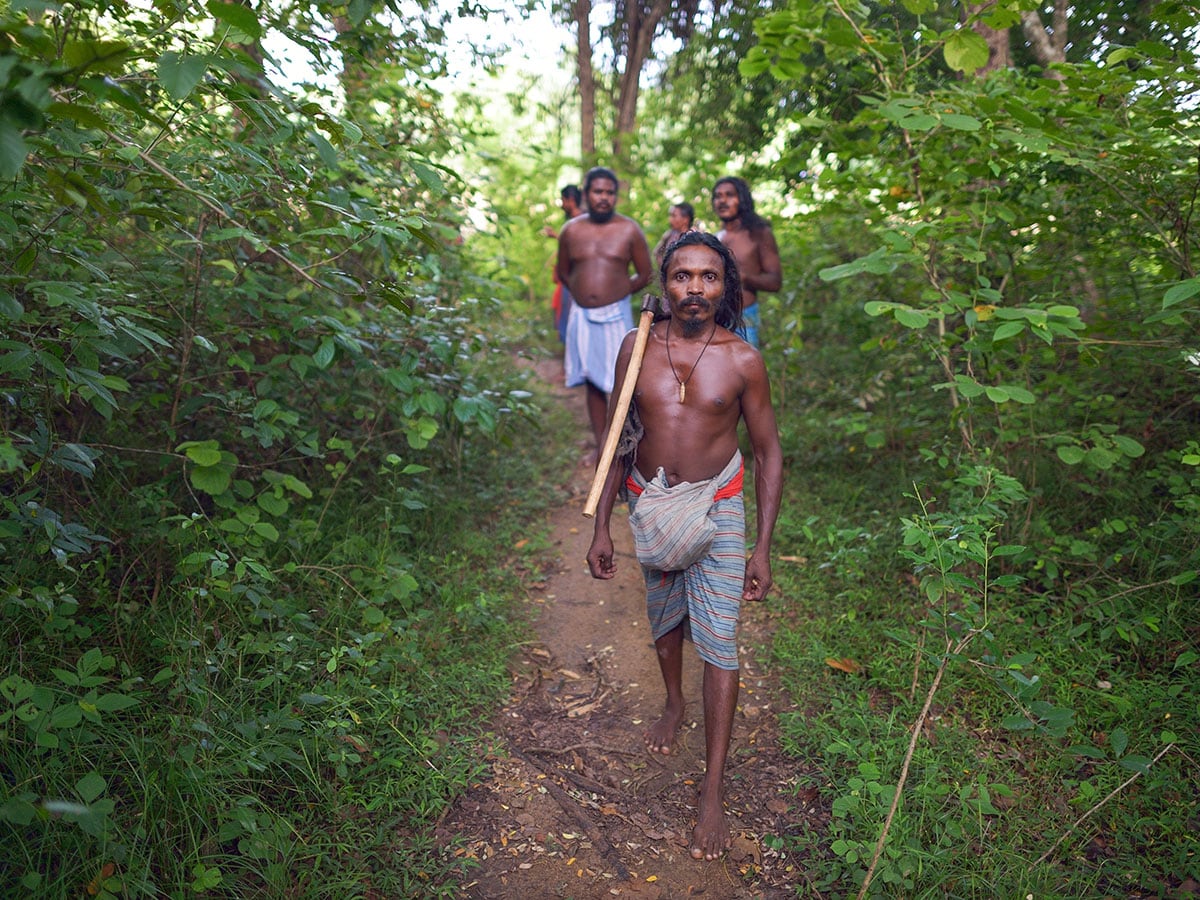 Sri Lanka’s forest-dwelling Veddas – the first inhabitants of this island and the last surviving bastion of their ancient way of life – have largely transitioned to village life
Sri Lanka’s forest-dwelling Veddas – the first inhabitants of this island and the last surviving bastion of their ancient way of life – have largely transitioned to village life
Image: Shutterstock
My journey through the rugged beauty of East Sri Lanka brought me to the enclave of Rathugala, set against the lush backdrop of Gal Oya National Park. An extended stay at Wild Glamping Gal Oya provided the rare opportunity to engage with the Veddas, Sri Lanka’s indigenous adivasi community, and, remarkably, both the first inhabitants of this island and the last surviving bastion of their ancient way of life.
Two lanterns and a circular signboard swayed gently from a green wooden frame. Our ride, a thatched-roofed jeep with purple accents, took us through a few kilometres of lush farmland, with the Bingoda Mountains quietly towering in the background. Committed to sustainable living, the solar-powered cottages, too, are framed by the mountains.
Wild Glamping Gal Oya proudly employs a majority of its staff from the Vedda tribe, fostering empowerment and support for the local community. That evening, draped in cascading green forest leaves from their waistlines, Veddas gathered in a circle around the fire to perform a ritual dance to bless us all. The evening culminated in a sumptuous traditional Sri Lankan feast, prepared by the local kitchen staff and the Veddas. Highlights of the farm-to-fork meal included velvety pumpkin soup, crispy medu and sago wadas, vellayappams, chicken curry and the ever-delightful pol roti (coconut flatbread), all capped with a refreshing homemade ice cream for dessert.
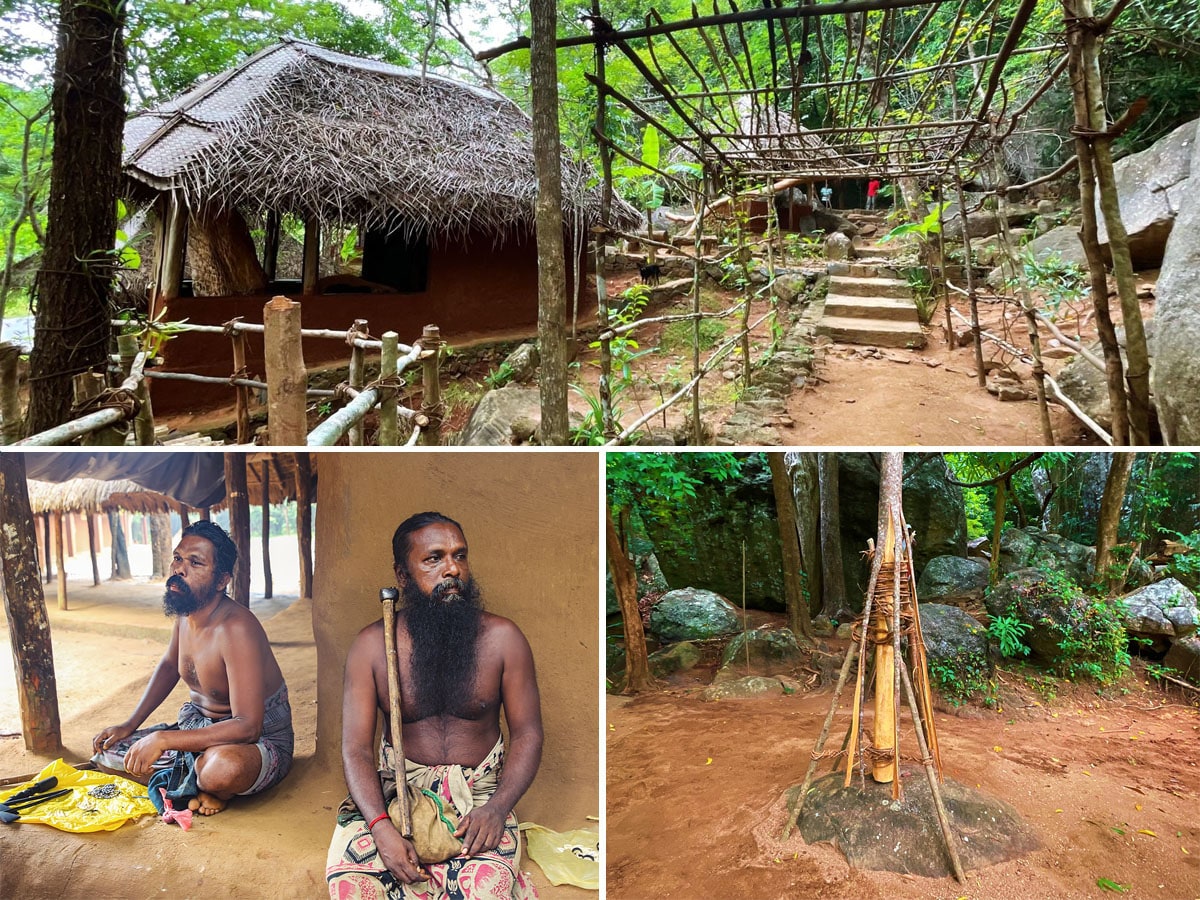 (clockwise from top) Veddas’ homes set against the backdrop of Bingoda mountains; prayer space of the Veddas; Veddas at their habitat.
(clockwise from top) Veddas’ homes set against the backdrop of Bingoda mountains; prayer space of the Veddas; Veddas at their habitat.
Image : Veidehi Gite, Shutterstock
The adventure, the next morning, continued with a refreshingly rustic shower experience in the semi-natural washroom of the luxury tent. There was an undeniable charm in the nostalgia evoked by the metallic buckets repurposed as the basin and shower—an ode to simplicity—yet balanced with a touch of sophistication as premium toiletries were thoughtfully presented in coconut shells. I took a morning walk through the nearby farms, which revealed an impressive variety of organic, pesticide-free vegetables. Guests are invited to handpick ingredients for a personalised farm-to-table meal by Chef Chandana Kumardasa. I returned with raw bananas, green chilies, long beans, snake gourd, lufa, and lemons.
A breakfast of fresh farm fruits offered the ideal start to the day, followed by a journey into the heart of the Vedda community, in their natural surroundings. At the core of this experience was a meeting with Suda Wannila Aththo, the chief of the Rathugala Veddas, and his deputy Gunabandila Aththo at the Rathugala Tourism Village. The air was thick with the earthy aroma of wood smoke and spices, mingling with the sound of cheerful chatter. The cultural centre unfolded like a scene from another time—a cluster of mud huts crowned with thatched palm roofs. Wooden bridges crisscrossed the space, linking these rustic dwellings and offering a window into the Vedda way of life.
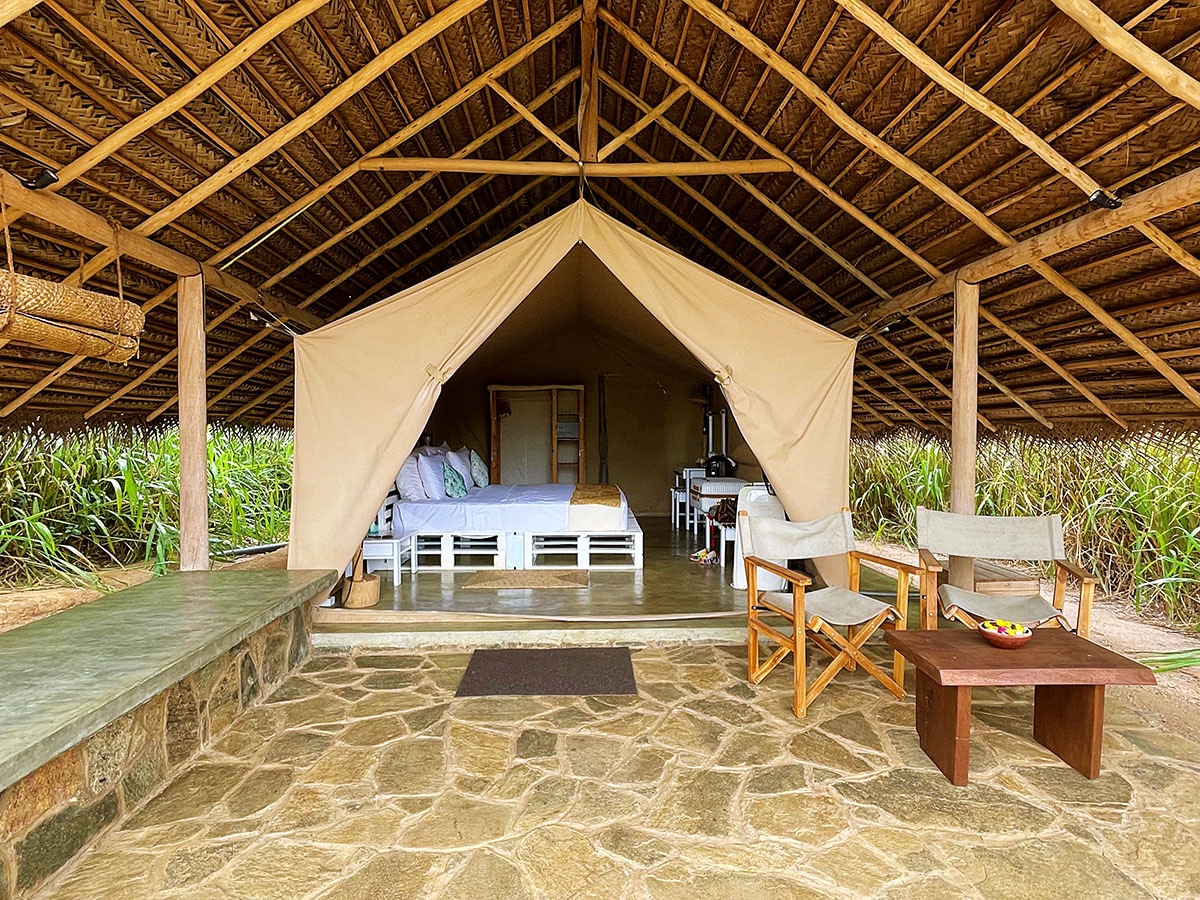 The solar powered luxury tent at Wild Glamping Gal Oya, committed to sustainable living.
The solar powered luxury tent at Wild Glamping Gal Oya, committed to sustainable living.
Image : Veidehi Gite
Inside the huts, stories of survival came to life—details of their hunting techniques, where traps, bows, and arrows were tools of necessity. Gunabandila, my Vedda guide, pointed to a set of black-and-white photographs taken by Richard Spittel, a Ceylonese physician and author and a familiar visitor to Vedda habitats in the early 1900s, showing the tribe hunting in the forest. His finger then traced across a map pinned to the wall, marking the tribe’s former homes scattered across the landscape—in the Danigala mountains and the surrounding deep forests earlier before they relocated to the Gal Oya forest. The clay-smeared rooms around us felt like a time capsule, with galleries showcasing images of ancient caves and statues of Vedda ancestors. While many of the Vedda people have embraced Buddhism, their deep connection to nature remains central to their beliefs.
“We teach our children not to take leaves or plants unless necessary and never to cut trees near streams, as it will cause them to dry up,” the tall, curly-haired deputy Aththo explained. “Though many young Veddas are unaware of their full history, they still have a deep love for food. They spend days foraging, sleeping in caves, catching fish, and hunting wild animals to cook over open fires.” After a brief uphill climb through a rocky terrain, Aththo—in his colourful sarong with an axe slung over his shoulder—gestured toward a shaded rock shelter tucked among swaying trees. “This is where the men and women lived,” he said. “And over there,” he added, looking at another direction, “is where the children played.”
 (Clockwise from above) A walk to the Vedda caves; a set of black-and-white photographs of Veddas taken by Richard Spittel, a Ceylonese physician in early 1900s; Ancient symbols of the Veddas
(Clockwise from above) A walk to the Vedda caves; a set of black-and-white photographs of Veddas taken by Richard Spittel, a Ceylonese physician in early 1900s; Ancient symbols of the Veddas
Image : Veidehi Gite
“We roasted rabbits, deer, and wild boars for our meals, and that was where our leader slept,” he pointed to a platform decked with a layer of stones. Aththo recalled the evenings when the Veddas would gather around bonfires, singing and dancing while working together to prepare meals and construct shelters. He acknowledged the challenges they encountered during their transition to a new way of life but spoke with immense pride about how far his people have come. Over the years, much has changed within these communities. The forest-dwelling Veddas have largely transitioned to village life, integrating with other Sri Lankans, participating in the broader economy, and, in some cases, intermarrying.
Also read: At Gujarat’s Shivrajpur beach, discovering the climate resilience of sea slugs
Suda Wannila Aththo spoke fondly of his old homes in the caves of Dahnigala’s dense forests and the journey that eventually led them to the village of Rathugala. He shared how, in the early 1950s, part of his community was relocated due to the construction of the vast Senanayake Samudhraya reservoir. It not only brought prosperity to the region but also fostered a thriving habitat for wildlife, giving rise to the Gal Oya National Park. In the years that followed, surrounding communities gradually relocated to the village due to hunting bans and increasing restrictions on traditional practices. Aththo says, “Though we no longer dwell in the forests, we have successfully preserved our rich culture and strong sense of community.”
We, then, ventured deeper into the forest, where he demonstrated the traditional hunting techniques of the Veddas. “We belong to the Danigala Maha Bandaralage lineage,” Aththo explained. “It was a title bestowed upon us by the Kandyan kings in 1476. Long before the Indo-Aryans arrived from India around 543 BCE, the Vedda were already living across the island, particularly in the Danigala mountain and surrounding forests.” However, a recent CSIR-CCMB (Centre for Cellular and Molecular Biology) study reveals that despite minimal linguistic similarities, the Veddas share significant genetic links with Indian ethnic groups.
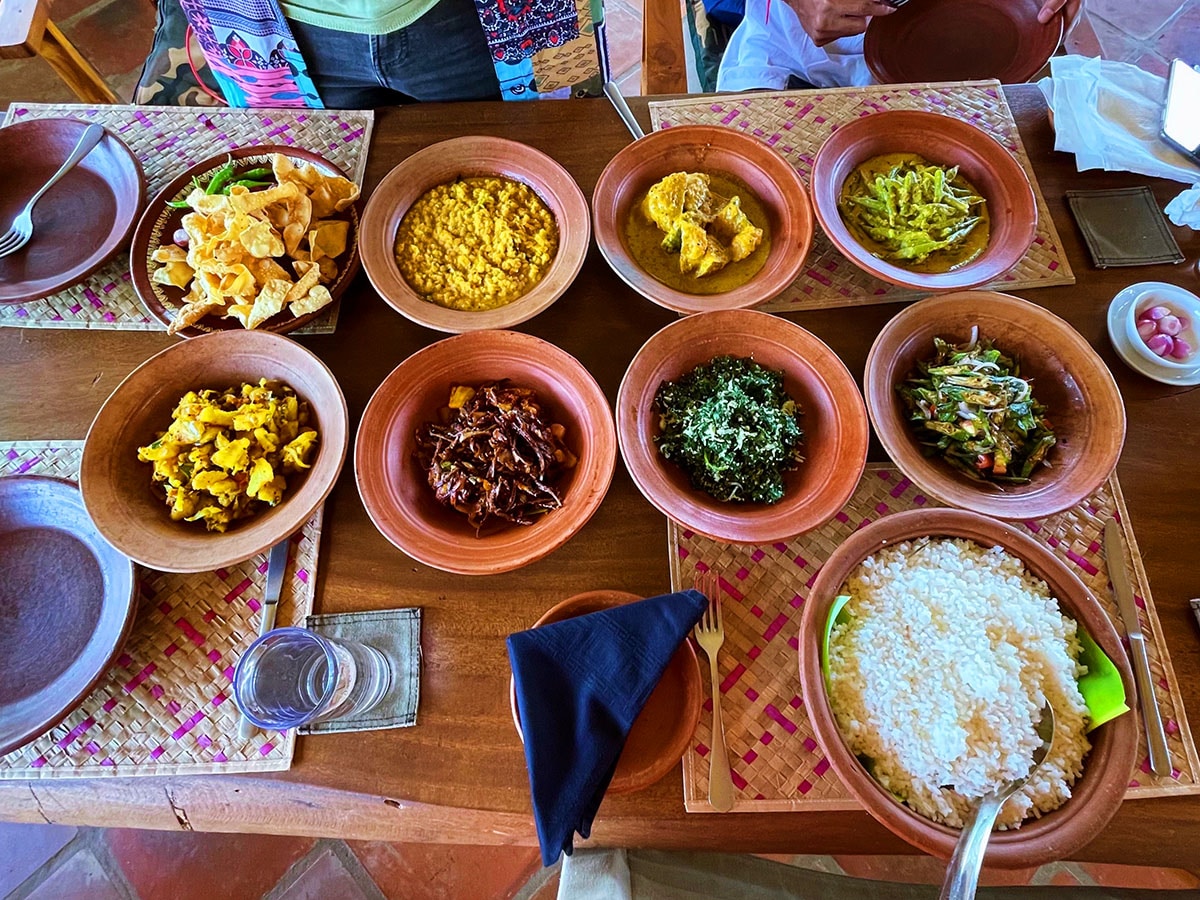 A sumptuous traditional Sri Lankan feast, prepared by the local kitchen staff and the Veddas
A sumptuous traditional Sri Lankan feast, prepared by the local kitchen staff and the Veddas
Image : Veidehi Gite
“Veddas, among Sri Lanka’s least studied indigenous communities, have long intrigued scientists with their unique cultural traits,” said K. Thangaraj, JC Bose Fellow at CCMB, in a press release. The research sheds new light on their genetic roots and connections to India.
While in Gal Oya, Aththo spoke as we walked through the forest, “The seven families who once lived in the Rathugala cave gradually integrated with nearby merchants after years of hunting, farming, and coexisting with Sinhalese farmers. However, as the Vedda community reclaims its heritage, there’s a renewed interest in the traditions of this indigenous Sri Lankan tribe, and things are slowly changing.”
Despite the changes over the years, these communities have not entirely lost their deep connection with the forests. They still embark on multi-day expeditions to collect honey, a practice rooted in their ancestral bond with the land. This tradition is known as “Karadha Thaniga.” Aththo vividly describes such expeditions. “Once located, we climb the trees to reach the hives, while using burning dry leaves to ward off the bees.” Veddas also preserve their beautiful songs and dances that accompany many of their hunting expeditions and celebration rituals.
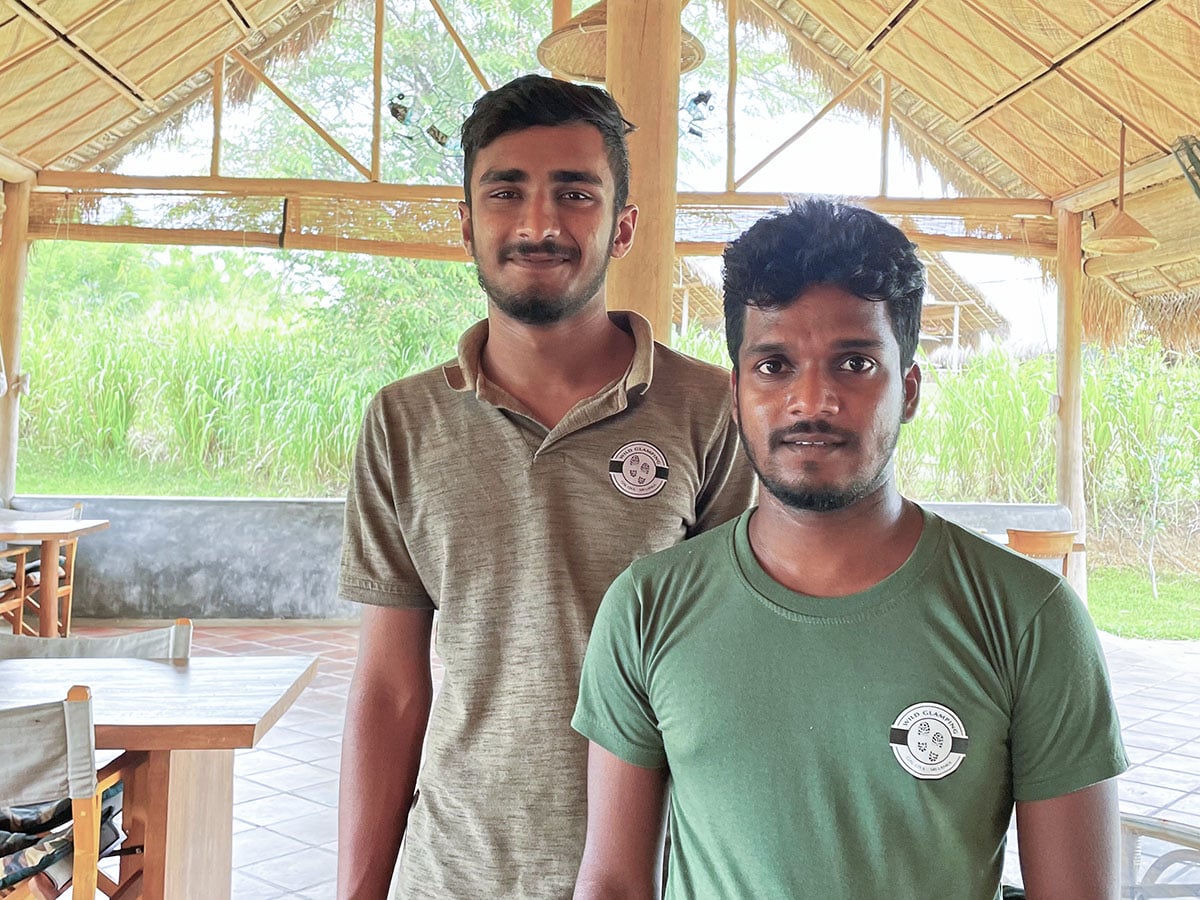 Wild Glamping Gal Oya proudly employs a majority of its staff from the Vedda tribe, fostering empowerment and support for the local community
Wild Glamping Gal Oya proudly employs a majority of its staff from the Vedda tribe, fostering empowerment and support for the local community
Image : Veidehi Gite
Aththo reflected on his lifelong fight against deforestation and the threats of illegal logging and encroaching cultivation. With a heavy heart, he described the sharp decline in biodiversity, noting how species like deer and pangolins, once plentiful, are now increasingly rare. Today, the Veddas rely on selling honey, beedi leaves, and taking up odd jobs to survive. However, limited economic opportunities are driving younger community members towards cities in search of better prospects. “I worry that our unique language and way of life are at risk due to this migration,” he says.
Upon my return, lunch at Wild Glamping Gal Oya was a delightful surprise. The fresh ingredients I handpicked from the farm that morning have now transformed into a beautiful meal, featuring an enticing lineup of banana blossom with sprat mellum, brinjal moju, pumpkin prawn curry, okra sambal, dry beans curry, Mysore dhal curry, Katuru Murunga melluma, and the rich chicken black curry. The farm-to-table food tour was a highlight, offering insights into the local food scene and a chance to sample the freshest produce. Over the following days, I spent time lounging by the pool and joined a deforestation tour, which led me through the once-lush forest, now scarred by illicit logging.
But at Wild Glamping Gal Oya, it’s a different story. With the treatment of wastewater and repurposed through reed beds, and stone and glass containers replace plastic, sustainability is woven into every detail.
